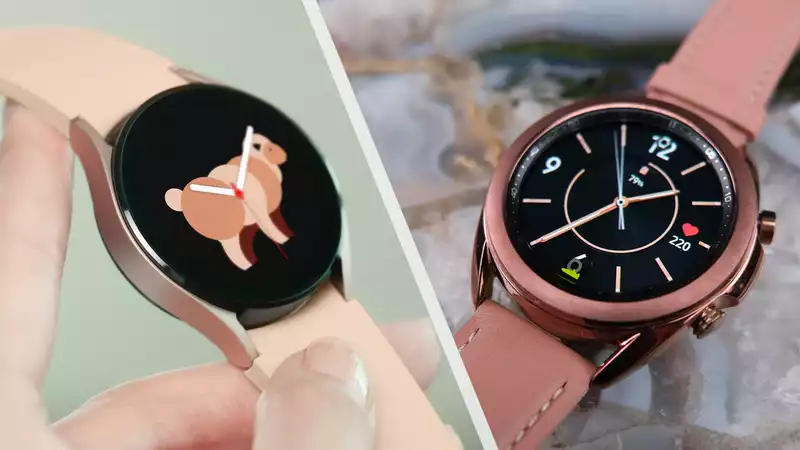Have you heard of the Samsung Galaxy Watch 4? The next generation smartwatch is finally here and offers several upgrades over the Samsung Galaxy Watch 3
The difference between the Samsung Galaxy Watch 4 vs the Galaxy Watch 3 depends on which model of Samsung's latest smartwatch you are considering The standard Galaxy Watch 4 is more similar to the Samsung Galaxy Watch Active 2, and the Galaxy Watch 4 Classic's design carries over the leather strap and physical bezel we loved on last year's model
However, there are many differences inside: the Galaxy Watch 4 has an all-new processor, and the new Wear OS and Samsung's One UI Watch platform work together Samsung has also introduced body composition analysis for the Galaxy Watch 4
Here's what you need to know about Samsung's Galaxy Watch 4 and Galaxy Watch 3 Also, for an in-depth analysis of the two new smartwatches, be sure to check out our guide on the Samsung Galaxy Watch 4 vs Galaxy Watch 4 Classic
The standard Galaxy Watch 4 starts at $24999 for the 40mm Bluetooth model and $29999 for the 40mm LTE model; the 44mm model costs $27999 for the Bluetooth model and $32999 for the LTE model
The Galaxy Watch 4 Classic starts at $34999 for the 42mm Bluetooth model and $39999 for the 42mm LTE model; the 46mm version is $37999 for the Bluetooth version and $42999 for the LTE version
At launch, the Galaxy Watch 3 was priced at $39999 for the 41mm model and $42999 for the 45mm model; the LTE models were $44999 and $47999 respectively Currently, however, the Galaxy Watch 3 can be purchased for much less
Samsung's Galaxy Watch 4 and Galaxy Watch 4 Classic have a redesigned frame that creates a seamless transition from the smartwatch casing to the strap The unified crown button also has a rectangular shape instead of a single protruding round crown accompanied by flat side buttons
So much for similarities Like the previous Galaxy Watch Active, the Galaxy Watch 4 fits snugly on the wrist and comes with a silicone strap For a more refined aesthetic, the Galaxy Watch 4 Classic comes with a genuine leather strap, a stainless steel case, and a rotating bezel
Overall, the Samsung Galaxy Watch 4 Classic and Galaxy Watch 3 share an enhanced aesthetic These smartwatches look more like traditional watches
Let me describe the new features of the Galaxy Watch 4 series compared to the Galaxy Watch 3 Most notably, the Tizen software from the Galaxy Watch 3 has been absorbed into the unified Google Wear OS (now called Wear OS 3) The interface looks familiar, and while Samsung's own programs such as Samsung Pay and Samsung Health are still prioritized, the smartwatch now includes Google's programs
In addition to Wear OS, the Galaxy Watch 4 is powered by Samsung's One UI Watch platform for better integration with Samsung's other device ecosystem and vice versa are automatically transferred The One UI Watch also leverages an extensive watch face library, including bubbly numbers, animated animals, and color-coordinated complications reminiscent of Android 12
As for health and fitness features, Samsung's new health sensor for the Galaxy Watch 4 combines heart rate monitoring (PPG), electrocardiogram reader (ECG), and bioelectrical impedance analysis (BIA) Similar to those found in the best smart scales, BIA applies a weak electric current to the body and analyzes body fat percentage, body mass index (BMI), muscle mass, bone mass, and body water percentage The measurement is taken for approximately 15 seconds with the finger placed on the crown button
Samsung has also improved sleep tracking metrics in its latest smartwatch Blood oxygen was measured once every 30 minutes on the Galaxy Watch 3, but once every minute throughout the night on the Galaxy Watch 4 More SpO2 readings may mean more insight into the quality of rest, especially for those with conditions like sleep apnea Sleeping next to a compatible smartphone also tracks snoring sounds
There are subtle differences in battery life between the Samsung Galaxy Watch 4 and Galaxy Watch 3 According to Samsung, the Galaxy Watch 3 lasts about two days on a single charge, but we had to charge it daily to keep up with the watch's usage Activity tracking and enabling the always-on display were the biggest drain on the battery
Samsung estimates the battery life of the Galaxy Watch 4 at 40 hours We estimate closer to a day We are still testing the new smartwatch though
Samsung's Galaxy Watch 4 is not an incremental upgrade from the Galaxy Watch 3 It's low-priced and completely refreshed The best part It feels familiar and doesn't require a huge learning curve or adjustment to the hardware or software [The previous generation models are great gadgets and will be supported with updates for at least three years But if you're ready for a new experience, a subtly sharper design, and upgraded health features, the Galaxy Watch 4 is a well-rounded successor










Comments